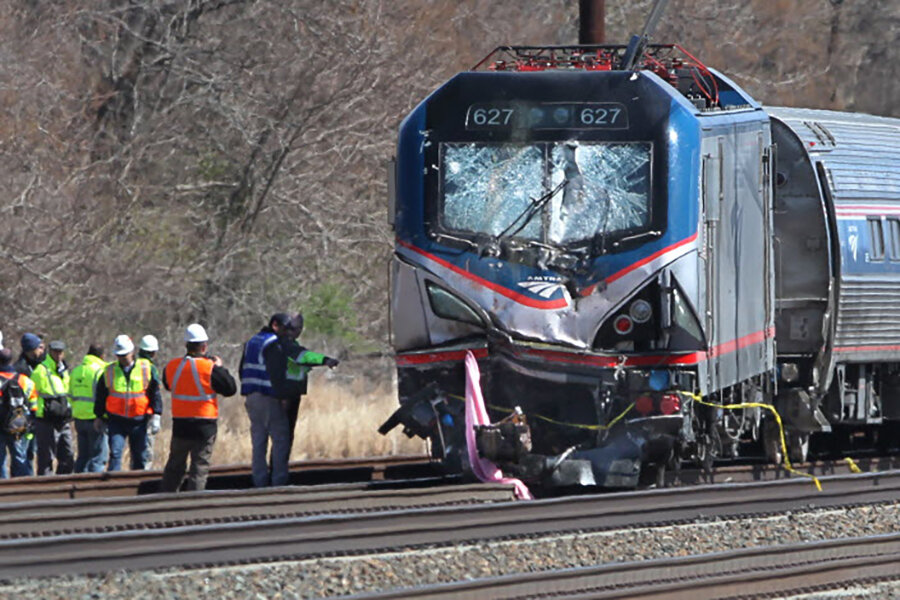Amtrak train crash: Are train safety controls at fault?
Loading...
An Amtrak train outside Philadelphia struck a piece of heavy equipment on the tracks on Sunday, causing the train's lead engine to derail and killing two Amtrak workers.
Amtrak Train 89 was traveling from New York to Savannah Ga., carrying about 341 passengers when it struck a backhoe in Chester Pa., killing the heavy’s machine operator and another worker, who has been described as his supervisor.
"I think we crumbled under the pressure," passenger Cristine Starke told CNN. "There's a hole, and it looks as if the train bent, and that was about two feet in front of me. It felt like an explosion. I ended up on the ground."
Some 35 passengers suffered injuries which were not considered life-threatening, according to the Chester Fire Department.
The deadly collision was at least the fifth serious incident for Amtrak over the past year, The Wall Street Journal reports, pointing to ongoing safety concerns despite an increased push for additional rail safety measures for passenger and freight trains.
"The rail-safety statistics have never been better, but nasty, nasty accidents are still occurring," Steven Ditmeyer, a former federal railroad official who is now a consultant, told the Journal.
Despite additional safety measures, such as a "positive train control" system introduced last year that automatically forces a train to follow speed limits, "there are still significant vulnerabilities that exist and have to be addressed," Mr. Ditmeyer said.
Investigators from the National Transportation Safety Board have recovered the train's event data recorder and forward-facing and inward-facing video cameras and are expected to focus on a key question: Why was the backhoe on the tracks as the train continued to barrel down?
The two Amtrak workers were part of an effort to replace ballast – the stone that stabilizes the railroad ties and track on the busy Northeast Corridor between Washington, D.C. and Boston, the Journal reports.
The collision appeared to violate Amtrak’s "20-step protocol" that details when equipment can be on the tracks and dictates that no trains are supposed to be on the tracks when equipment is present, said Sen. Chuck Schumer (D) of New York.
"Clearly this seems very likely to be human error," Senator Schumer told the Associated Press, saying Amtrak should review its processes. "There is virtually no excuse for a backhoe to be on an active track."
The Amtrak crash was one of three train accidents on Sunday, including an incident in Somonauk, Ill., where a train struck a vehicle at railroad crossing, killing one man; and another in Pennsylvania’s Bucks County where a trespasser was struck by a train but not killed, an Amtrak spokesman told CNN.
Amtrak trains make up a relatively small portion of train accidents compared to private freight carriers, according to statistics from the Federal Railroad Administration. There were 12 accidents on Amtrak trains in 2015, about 3 percent of the overall total, the agency found.
Sunday’s crash comes almost a year after an Amtrak train in Philadelphia derailed while speeding through a tight curve, killing eight passengers and injuring more than 200 others.
Amtrak employee injuries have also been increasing despite the national rail carrier’s efforts to improve safety. In 2013, there were 1,301 employee injuries, up from 695 in 2009, according to a February 2015 report from Amtrak’s Office of Inspector General.
The carrier’s behavior-based safety program – where a fellow worker meets with Amtrak employees, observes their behavior and provides feedback – has also faced criticism from employees’ unions. Amtrak says it will compile this information into a database to help workers identify safe and unsafe actions.
Officials from the rail carrier have pledged to work with employees to improve the system's safety.
"Something different has to go on here," Joseph Boardman, Amtrak’s president and chief executive told the Journal. "We cannot lose lives like this. People should expect to be able to go home at night with all their fingers and toes – and actually go home."
Amtrak trains will run as regularly scheduled on Monday, the carrier said, though commuters may face some delays on services between Philadelphia and Wilmington, Del.







